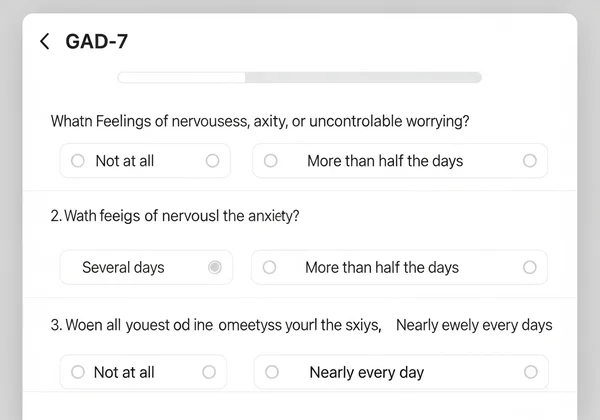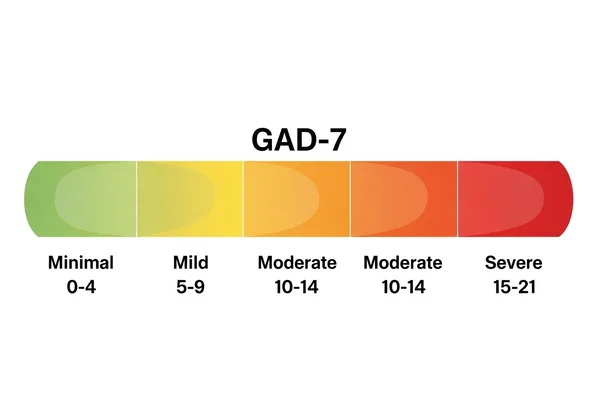Your Anxiety Resource Hub: GAD7 Scores & Solutions
Feeling overwhelmed, constantly on edge, or trapped in a loop of worry? You're not alone, and understanding these feelings is the first empowering step toward managing them. This resource hub is designed to be your trusted guide. We will explore the nature of anxiety, introduce a scientifically validated tool to help you measure it, and show you how to turn your results into actionable solutions. What is GAD7? At the heart of this journey is the GAD7 assessment, a simple yet powerful tool for gaining clarity.
Anxiety can feel like an abstract, all-encompassing fog. But by using a clear, objective tool like the one offered here, you can begin to map it out. This guide will walk you through everything you need to know, from the basics of anxiety to interpreting your score and finding the right path forward. Your journey to understanding starts now. If you're ready to gain immediate insight, you can take the GAD7 assessment on our homepage.

What is Anxiety? Understanding the Basics
Before we measure anything, it’s helpful to understand what we're looking at. Anxiety is a natural human response to stress—a built-in alarm system. However, when this alarm is stuck in the "on" position, it can significantly impact your daily life. It’s more than just feeling stressed about an upcoming deadline; it’s a persistent state of apprehension or unease.
Common Symptoms and Types of Anxiety
Anxiety manifests differently for everyone, but there are common signs. Physically, you might experience a racing heart, shortness of breath, or muscle tension. Emotionally, you could feel a sense of dread, irritability, or an inability to relax. Behaviorally, it might lead to avoiding certain situations or people. Recognizing these anxiety symptoms is the first step toward addressing them. While there are many types of anxiety disorders, the GAD-7 specifically screens for Generalized Anxiety Disorder (GAD), characterized by chronic and excessive worry about various aspects of life.
The Difference Between Stress and Anxiety
Many people use the words "stress" and "anxiety" interchangeably, but they are distinct. Stress is typically a response to an external trigger, like a heavy workload or a difficult conversation. Once the trigger is gone, the stress usually subsides. Anxiety, on the other hand, is more internal. It’s the persistence of worry and unease even when the external trigger is gone. Think of it this way: stress is the reaction to a traffic jam, while anxiety is worrying about future traffic jams even when the roads are clear.
The GAD-7: Your First Step to Understanding
To move from a vague feeling of worry to a clear picture, you need the right tool. The GAD-7 (Generalized Anxiety Disorder 7-item scale) is a brief, effective, and clinically validated self-report questionnaire. It is one of the most widely used tools by healthcare professionals globally for screening for anxiety and tracking the severity of symptoms over time. It provides a simple, numerical score that helps quantify what you've been feeling.
How the GAD-7 Works: A Quick Overview
The process is straightforward and quick. The GAD7 questionnaire consists of seven questions, each asking you how often you have been bothered by a specific symptom over the last two weeks. You answer on a four-point scale, from "not at all" to "nearly every day." The scores for each question are then added up to give you a total score ranging from 0 to 21. This entire process can be completed in just a few minutes, providing you with immediate feedback. You can try your free GAD-7 test to see how simple it is.

The Importance of a Validated Screening Tool
In a world full of online quizzes, why trust the GAD-7? Because it's backed by science. Developed by Drs. Robert L. Spitzer, Kurt Kroenke, Janet B.W. Williams, and associates, the generalized anxiety disorder 7 item scale has been extensively researched and proven to be a reliable and valid measure of anxiety symptoms. Using a validated tool ensures that your score is a meaningful reflection of your experience, providing a solid foundation for any next steps you might take.
GAD-7 Score Interpretation: What Does Your Score Mean?
Receiving a number is one thing; understanding its significance is another. Your GAD-7 score is a snapshot of your anxiety symptoms over the past two weeks. It’s a compass, not a map—it shows you where you are so you can decide which direction to go. This immediate feedback helps demystify your feelings, transforming a general sense of "I feel anxious" into a more concrete "My symptoms are in the moderate range."
GAD-7 Score Ranges: Mild, Moderate, Severe Anxiety
The GAD7 scoring system is designed for easy interpretation. The total score is categorized into four main levels, giving you a clear indication of symptom severity:

- 0-4: Minimal Anxiety. Your symptoms are likely within the normal range and may not require intervention.
- 5-9: Mild Anxiety. You may be experiencing some symptoms that are noticeable but generally manageable.
- 10-14: Moderate Anxiety. Your symptoms are likely causing you distress and may be interfering with your daily activities.
- 15-21: Severe Anxiety. Your symptoms are very likely causing significant impairment in your life, and professional consultation is highly recommended.
Ready to see where you stand? Understand your score in minutes.
Remember: Screening vs. Diagnosis
This is the most critical point to remember: the GAD-7 is a screening tool, not a diagnostic test. It is exceptionally good at identifying the presence and severity of anxiety symptoms. However, it cannot tell you why you have them or give you a formal clinical diagnosis. A diagnosis can only be made by a qualified healthcare professional, such as a doctor, psychiatrist, or psychologist, after a comprehensive evaluation. Think of your GAD-7 score as valuable information to bring to that conversation.
From Scores to Solutions: Your Personalized Anxiety Action Plan
A score is just the beginning. Its true power lies in what you do with it. The goal is not just to know the number but to use it as a catalyst for positive change. Whether your score is low or high, it provides a valuable opportunity to reflect on your mental well-being and create an anxiety action plan that works for you.
Immediate Steps: Lifestyle Changes & Self-Care
If your score falls in the mild to moderate range, or even if you just want to be proactive, there are many effective self-care strategies. Regular physical activity, a balanced diet, and sufficient sleep are foundational pillars of mental health. Practices like mindfulness meditation, deep-breathing exercises, and journaling can also be powerful tools for managing anxiety. These are not quick fixes but consistent habits that build resilience over time.

When to Seek Professional Help
If your GAD-7 score is in the moderate to severe range, or if your symptoms are causing you significant distress regardless of the score, it is a strong signal to seek professional help. A high score is not a sign of weakness; it's a sign that you deserve support. Speaking with a doctor or mental health professional can help you get an accurate diagnosis and explore effective treatment options, such as therapy (like CBT) or medication. The results from our confidential tool can be an excellent starting point for that conversation.
Navigating Your Journey: Resources & Support
Your journey to well-being is unique. On our platform, we go beyond just a score. After completing the assessment, you have the option to receive a unique, AI-powered personalized report. This report analyzes your specific answers to provide deeper insights into your strengths, potential challenges, and how your symptoms may be affecting your life. It offers a truly personalized guide to help you navigate your next steps. This is more than just data; it's a starting point for self-discovery and action.
Understanding your anxiety isn't about labeling yourself; it’s about empowering yourself with knowledge. By taking a few minutes for a confidential assessment, you are taking a courageous step toward self-awareness, replacing uncertainty with clarity. This knowledge gives you the power to make informed decisions, whether that means implementing new self-care routines or seeking professional support. Cultivating your mental well-being is an ongoing process. Let the GAD-7 be a key milestone. We invite you to start your self-assessment now, discover your score, and take the next step on your path to feeling better.
Frequently Asked Questions About GAD-7 and Anxiety
What is the age range for the GAD-7?
The GAD-7 was originally validated for use in adults. However, it is also frequently used by clinicians to screen for anxiety in adolescents (typically ages 12 and up). If you are a minor, it is always best to discuss the results with a parent, guardian, or healthcare professional.
How accurate is the GAD-7 test?
The GAD-7 is considered a highly reliable and valid screening tool. Research has shown that it has strong psychometric properties for identifying probable cases of Generalized Anxiety Disorder and other anxiety disorders. Remember, its accuracy is for screening, not for providing a definitive diagnosis.
What is the difference between GAD-7 and PHQ-9?
This is a great question as they are often used together. The GAD-7 screens for anxiety symptoms, while the PHQ-9 (Patient Health Questionnaire-9) screens for symptoms of depression. Since anxiety and depression often co-occur, healthcare professionals frequently use both tools to get a more complete picture of a person's mental health. Our focus here is on the free anxiety screener.
Can I use the GAD-7 for someone else, like my child?
It is natural to worry about a loved one. However, the GAD-7 is a self-assessment tool, meaning its accuracy relies on the individual's personal reporting of their own feelings. The best way to help is to share this resource with them, allowing them to take it themselves in a private, supportive environment when they feel ready.
Where can I find a printable GAD-7 form (PDF)?
Printable GAD-7 PDF versions are available online. However, the key advantage of using an online tool like the one on our site is that you get instant, automatic scoring, clear score interpretation, and the unique option for a detailed, AI-powered personalized report to guide your next steps—features a static PDF cannot offer. Get your results now and see the difference.